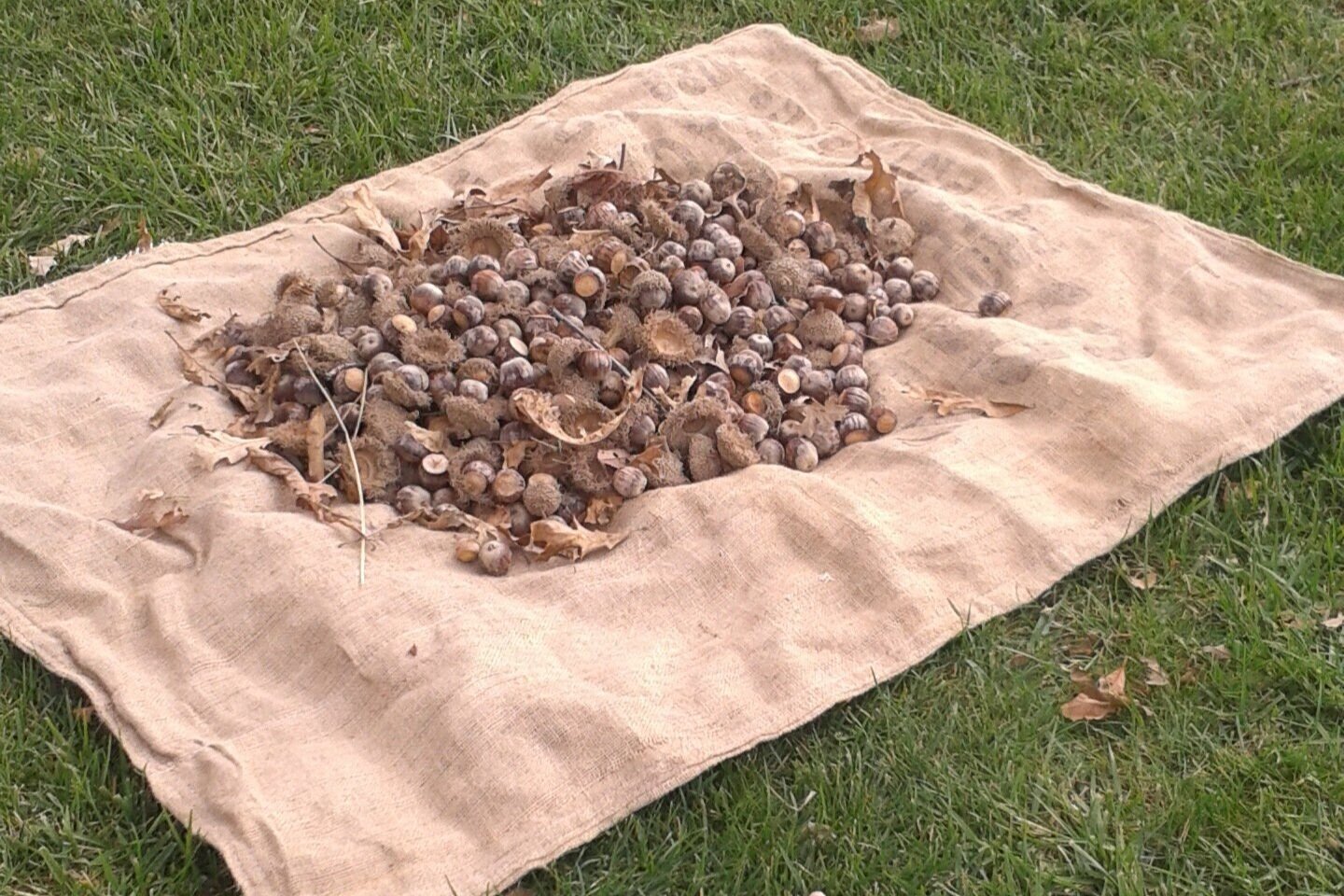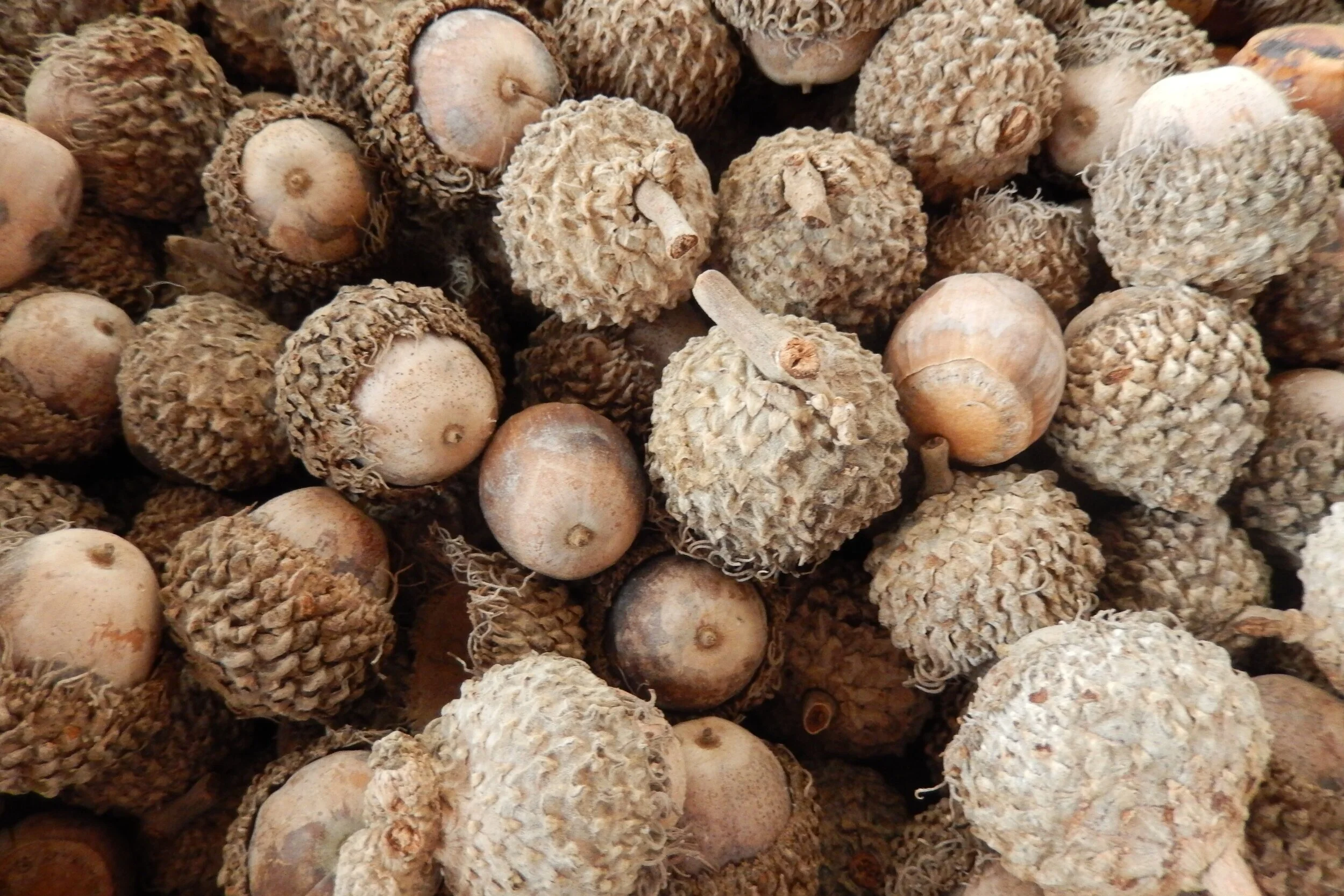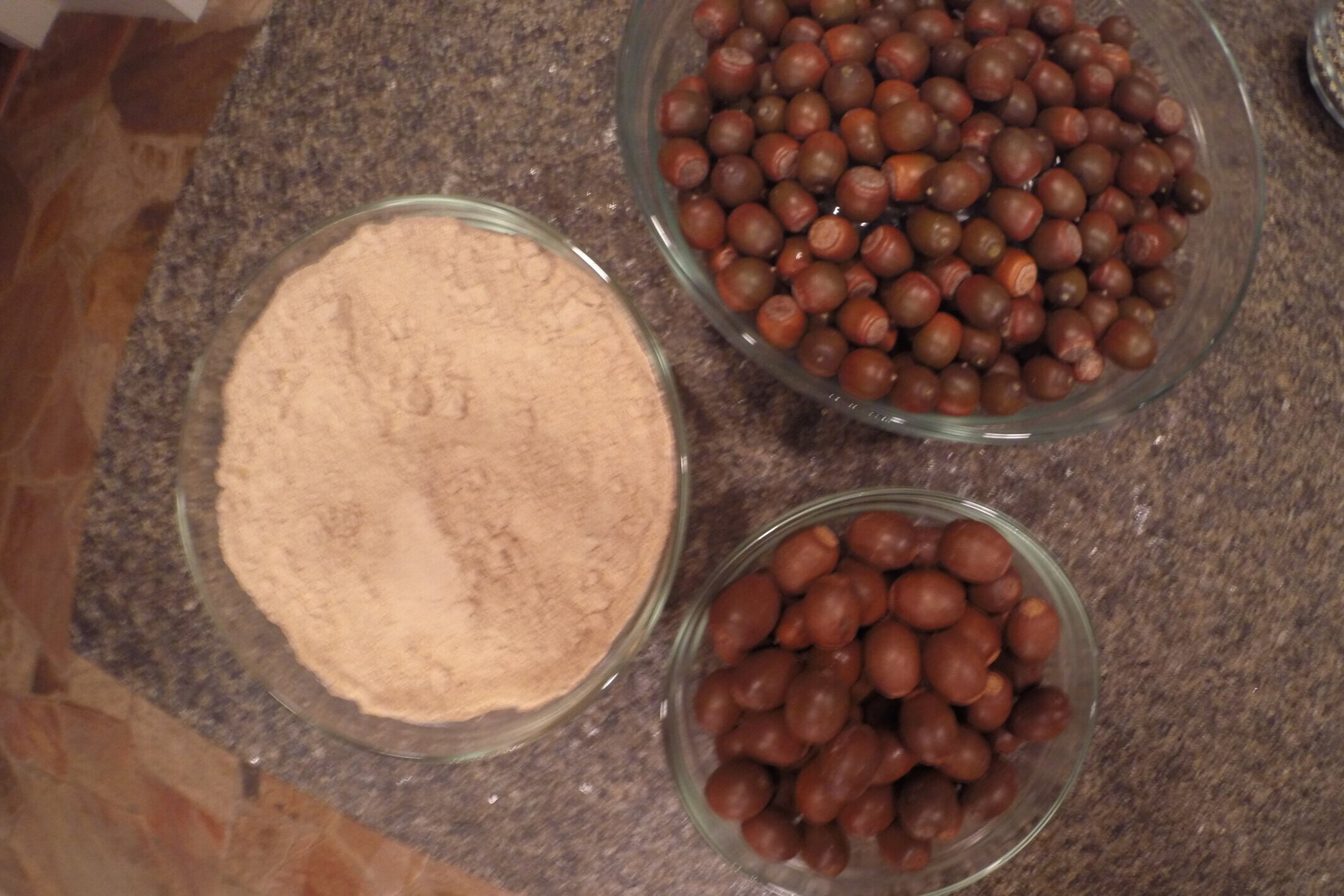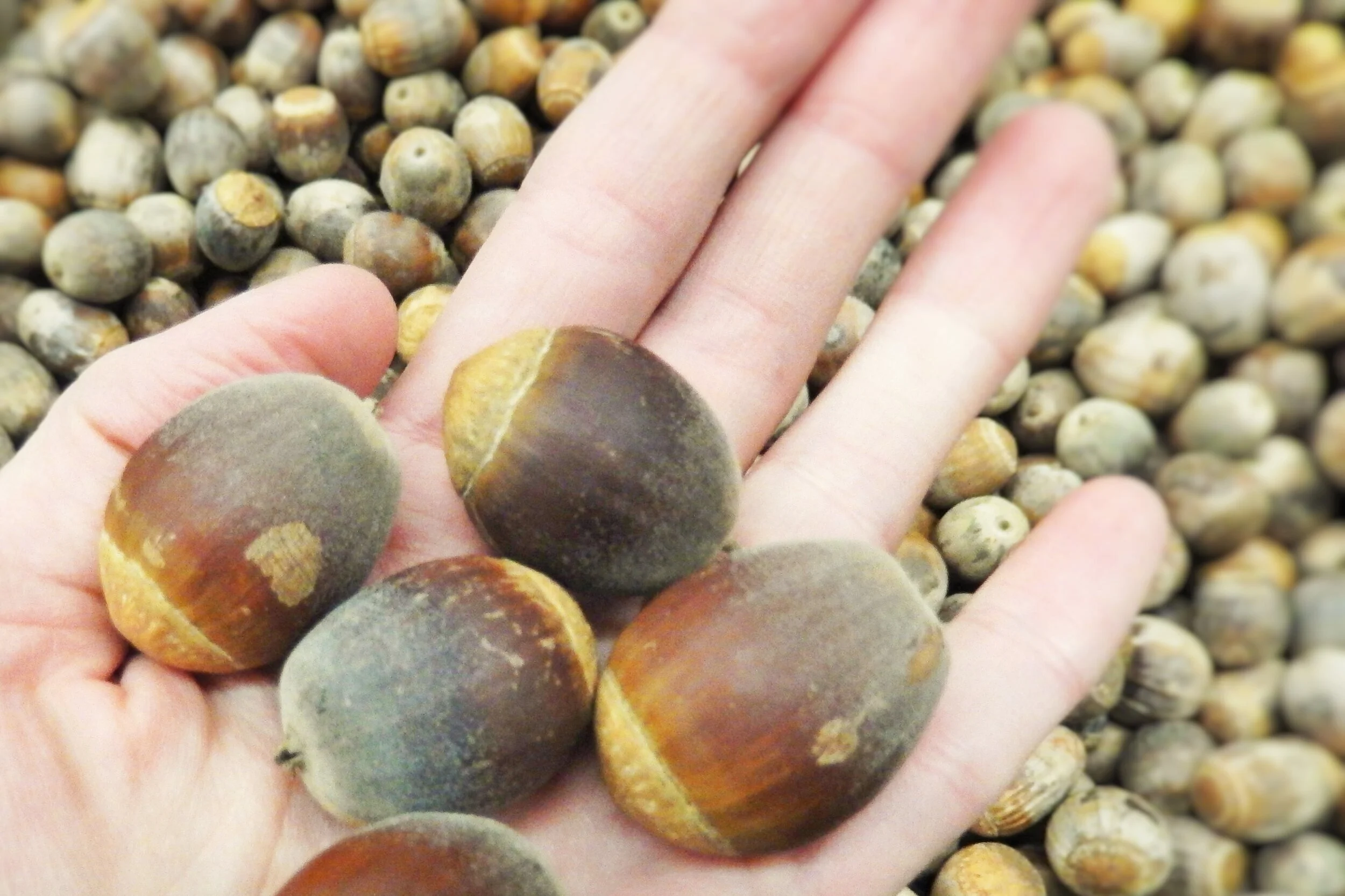How to Make Acorn Flour
Step 1: Collecting Acorns
What types of oaks produce acorns?
All oaks bear acorns. There are over 90 varieties of oaks in the United States, and over 400 globally. North American oaks can be separated into three categories: red oaks, white oaks, and golden cup oaks. If you are looking for the differences between the U.S. varieties, we recommend this field guide. If you are a true quercophile, you can see more reference guide recommendations from the International Oak Society here.
Oaks (quercus spp.) belong to the family Fagaceae. Also belonging to this family are several oak cousins: chestnuts (castanea spp.), beeches (fagus spp.), chinquapins (chrysolepis spp.), tanbark oaks (notholithocarpus densiflorus), and others. As you might guess, because of the family resemblances, processing acorns is very similar to processing chestnuts, and many of the techniques in this guide were borrowed from this industry. Many California foragers of acorns also collect tanbark acorns for processing. Suellen Ocean, author of the cookbook Acorns N'Eat em, claims tanbark acorns are the best tasting varietal.
Which trees produce the most acorns?
Many oak varieties are being produced for the purpose of increasing acorn production for wildlife management, and some have even been bred for nut consumption. The standout U.S. nurseries are Forrest Keeling, Morse Nursery, Native Foods Nursery, Oikos Tree Crops, Nativ Nurseries, and St. Lawrence Nurseries. Possible Canadian nurseries are GrimoNut Nursery, Rhora’s Nut Farm, and Nutcracker Nursery. However, performance will vary by soil type, waterfall, geography, and other factors. It typically takes up to 20 years for an oak to start producing acorns. Some of the varieties bred by these nurseries claim acorn production as soon as five years.
How many acorns fall from a tree?
Oaks exhibit masting behaviors. This means that the oaks store up their energy and alternate between periods of high acorn production (called mast) and lower acorn production. According to Ian Pearse “masting is the intermittent and synchronized production of seeds.” Thus, some years collectors will be able to gather 500 pounds from one tree and the next year it may only be five pounds from that same tree. Many other plants like pecans and walnuts follow this rhythm, and it is believed to have evolved over time as a defense mechanism.
How do you collect acorns on site?
The key is watching the trees for when the acorns are dropping. The first drop of acorns is usually not the best since the tree will naturally drop the weevil infested acorns first.
The next wave of acorns is the optimum collection window. Acorn collection is best at the point when you can turn an acorn in its cap and the seed releases easily from the tree. It should also be brown in color, not green.
We found the best collection spots to be flat grassy areas. These locations can be mowed before the acorn drop. Typically, there will be lots of sticks under these trees, which should be gathered beforehand to have a clean field. We preferred using a bag-a-nut to pick up the acorns in order to save our backs from bending over with a bucket. Alternatively, if you are only needing to gather a few pounds, the nut wizard or the stab-a-nut works well. For more information on proper foraging equipment click here. Whatever you choose, it is critical to sanitize your equipment before and after collection in order to prevent spreading tree diseases such as oak wilt or sudden death.
Some collection sites do not allow for such equipment and preparation, so many foragers opt to place tarps on the ground below a tree and hit the tree with a stick or pole (swimming hooks do the trick!). It is easy to fold up the tarp and keep all the acorns; however, there is more sorting required after the fact since you will have leaves and sticks fall on your tarp. This can be sorted using an air sorter.
If you are really lucky, and you have a stand of oaks with space in between that is navigable by machine, you may use a tree shaker to help collect your fruit. There are also tree shaking tractor implements. These are more commonly used for nut orchard harvesting. We found a few farms and ranches in Texas that allow pecan harvesters onto their property to shake native pecan stands. Contract terms for these arrangements were such that the landowner received 40% of the proceeds from sale of the nuts. These same harvesters can be used for acorns in bulk, but contractual terms will be negotiable.
For further reading on seed harvesting, click here.
Where can you source acorns and how much does it cost?
The acorn collecting spectrum is pretty wide. You will find people that give away product for free and others that charge you more than the price of walnuts or pecans. There is quite a wide bid-ask depending on the variety, volume, and your location.
The majority of acorns are sourced and sold as seed for nurseries and tree farms. The market for seed for landscaping is more valuable than the market for acorns as a nut. Seed collectors can charge up to $3.50/lb. for some cultivars. There are a few permaculture farms that recognize this value and grow acorns for consumption, which can reach prices as high as $8.00! Typically, you see price discounts for buying in bulk as purchasing acorns by the packet can be grossly overpriced.
On the other hand, you can negotiate with large ranchers and timber stand owners to collect on their land for low prices. When we were looking to build our collector network, we sent out surveys to landowners. See a copy of that survey here.
There are many state agencies that operate to collect seed for their own reforestation operations. Sadly, many of these are closing due to low funding, lack of experienced talent, or outsourcing. If you are lucky, you can approach these state organizations to help collect and clean your seed.
Further reading:
“Cues versus proximate drivers: testing the mechanism behind masting behavior” by Ian Pearse et.al
“Acorn Production Patterns” by Walter D. Koenig et. al
“Acorn Production in Red Oak” by Daniel C. Dey
“What drives masting? The phenological synchrony hypothesis.” by Walter D. Koenig et. al
“Mechanisms of mast seeding: resources, weather, cues, and selection” by Ian Pearse et. al
“The Woody Plant Seed Manual” by USDA Forest Service Agriculture Handbook 727
“After Lean Acorn Crop in Northeast Even People May Feel the Affects” by Ritchie S. King
Step 2: Separating Acorn Caps from Nuts
How do you remove acorn caps from the seed?
Bur oak acorns (q. macrocarpa) have large caps that are tricky to remove from the acorn. There are also other varieties like the overcup oak (q. lyrata) that completely cover the acorn. Bur oak acorns evolved to live in many different parts of the middle United States. Given this large expanse of territory, there are many variances within the species as far as acorn and cap size which makes mechanization difficult due to lack of uniformity.
Mighty Wild never accomplished making a machine that could help with the task of cap separation, but there are a few lessons learned. First, acorns come out of their caps more easily when dry. Second, some hybridized varieties are more easily removed from their caps. One method employed was to tumble the acorns in a small concrete mixer. This tactic worked on over 50% of the batch. Lastly, bur acorns float when they are inside the caps, making a float test separation impossible. However, you can create machinery to take advantage of this characteristic similar to how the apple industry employs water baths in their processing line. The water bath would float the acorns all the same way making it easier to align them into a pair of rollers or other machinery to remove the caps. Alternatively, if you know you are going to shell the acorns, some shelling equipment can remove the caps as well.
How do you ensure acorn quality?
Harvesting acorns is the first step in a chain of food quality and safety standards. There are many ways that traceability and good data logging can help with the quality. However, knowing the characteristics of each acorn species can also help you maintain quality. For example, quercus alba (white oak) is prone to sprouting quickly. Some collectors even purport sprouting of the acorns while still on the tree. Other acorns have a long dormancy period.
We made sure to ask our collectors lots of questions about quality and safety and to establish standards. See our collector questionnaire, traceability questionnaire, and lot tags. We even hoped to one day track collection by tree using QR codes. When evaluating a batch, we used the following nut grading sheet. For the best guide of nut manufacturing food safety, click here.
What are acorn weevils and are they harmful?
Acorn weevils are not harmful to humans. In fact, some people eat acorn weevils. However, acorn weevils do eat the nutmeat inside an acorn lowering the quality of your harvest. Usually you can see holes in acorns where the acorn weevil in the larval stage has eaten its way out of the nut. The acorn weevil will then bury itself in the ground and emerge the next year as a beetle with a long snout. The beetle uses this snout to insert eggs into immature acorns in mid-summer, and the process starts over again.
Acorn weevils are of the genus curculio. One important thing to remember is typically once a weevil emerges from the acorn it will not drill into a nearby acorn for more food. Thus, when storing acorns, you don't need to worry about them invading your stockpile. Now grain weevils are a different beast altogether, and you will need to watch out for those.
What other pests do you need to worry about?
Grain weevils, gypsy moths, and oakleaf caterpillars, oh my! For more information on the major insect and mite pests of oaks, click here.
How do you separate your acorns? What is a float test?
In order to separate weevil infested acorns from quality acorns, many employ what is called a “float test”. The acorns are placed in a bucket with water. The floating acorns are discarded, and the good acorns sink to the bottom. This method is recommended for large batches as it is faster than visual inspection. One thing to consider is the additional moisture can be a catalyst for sprouting. The test can also give some false negatives if your batch of acorns has dried out.
In our experiments at Mighty Wild, we used a large horse trough to handle these larger volumes, using a pool skimmer to remove the discards from the top. We also saved water by using a submersible utility pump to drain the water from one trough to another when the test was complete. An additional food safety step you can employ here is to add a chlorine wash to the tank. You can use pH strips to test the strength of the solution, but the general rule of thumb is one tablespoon of household bleach in one gallon of water is equivalent to 200 ppm of sanitizing solution. Remember to rinse the acorns after this washing step. If you are looking for an organic alternative, the carrot industry relies on chlorine alternatives and ozone solutions.
Another method to separate acorns is to do so by weight using an air sorter. They make these for pecans, walnuts, and macadamia nuts. This equipment can be easily retrofitted for acorns. Some acorn collectors use this method for bur oak acorns with caps since the float test will not work on that variety until the cap is removed.
Step 3: Drying Acorns
Drying is the most important step and can happen at several points along the way depending on throughput scale and processing methods. Improper drying can lead to food safety issues or change the organoleptic properties (taste, color, odor, etc.) of the acorn. The rate and temperature of drying can also affect the nut properties. For example, bur acorns have a thin shell and can crack when drying in-shell if the heat is too high. Mighty Wild had many trials and errors with drying nuts in shell and recommends shelling after float testing rather than drying nuts in shell. However, large volumes might require this step. Improper drying can lead to post-harvest loss. You can look to many other types of food products for inspiration on how to dry your nuts.
How do you dry acorns?
Mighty Wild used large drying bins with a Sukup heater attachment that was engineered by our great partner, Mark Friesenhahn, at Comal Pecan Farm.
In many rural areas, food products are dried in the open air on tarps. This is how most coffee and spices are dried in Africa, and drying can last only a few sunny days. However, this method can lead to food quality issues with pests and weather. Pecan and walnut harvesters in the Midwest bag their nuts and leave them in stacks outside. This method works in cold areas with enough air flow, but acorns have too high of a moisture content to allow for this. You will experience sprouts and moldy acorns if you employ this method.
Another method is to create a solar dryer. Hohenheim University made the following model that is used at an acorn farm in Kea.
Another rural Midwest collector took large fans and soldered them onto both ends of a mobile home allowing the breeze to dry the acorns resting inside. This is not recommended as a food safe method.
When are acorns dry?
For most crops, farmers rely on moisture content or relative humidity meters in order to verify when their crops are dry. Since there is not a moisture sorption isotherm for acorns comparing relative humidity to moisture content, Mighty Wild had to experiment greatly with this concept. We used relative humidity monitors and dried acorns to find mixed results. In the end, the best test for moisture is to use water activity as the preferred metric. We used a Meter Group Pawkit for this purpose.
In terms of avoiding mold growth, the water activity level to aim for is lower than .82. For food safety purposes, Dr. Linda Harris recommends less than .7. In order to pinpoint a target water activity for quality purposes, one needs to be determined by correlating taste and texture data with the water activity. One way to do this is to take several nuts at similar high water activities and dry them to different water activities. Then you can correlate the taste and texture characteristics with each given water activity.
Acorns have a high moisture content, and drying acorns improperly can lead to rancidity and oxidation. Acorns tend to turn brown very quickly with handling due to oxidation. We saw browning when sizing acorn nutmeat in the next step as well as browning from over-drying. Experimentation with drying at different rates and temperatures is key to resolving these sensitivities as there are differences among each varietal.
Further reading:
“The Effect of Drying Quercus robur Acorns to Different Moisture Contents, followed by Storage, either with or without Imbibition” by Peter G. Gosling
“Effect of acorn flour on the physico-chemical and sensory properties of biscuits” by Antonella Pasqualone, Fatima Z. Makhlouf, Malika Barkat, Graziana Difonzo Carmine Summo, Giacomo Squeo, and Francesco Caponioa
“Study of Effective Moisture Diffusivity of Oak Acorn” by Habibeh Nalbandi, Sadegh Seiiedlou, Hamid R. Ghasemzadeh, Naser Hamdami
“Determining seed moisture in Quercus” by F.T. Bonner
“Storage of Seeds” by F.T. Bonner
http://www.doiserbia.nb.rs/img/doi/1450-8109/2005/1450-81090502173R.pdf
https://pdfs.semanticscholar.org/69dc/dbd1fb6c4119ee9172ebb5eb91a283c37cca.pdf
https://rngr.net/publications/tpn/24-3/pdf.2005-06-21.4885222930/at_download/file
Step 4: Sizing, Sorting, and Shelling Acorns
How do you size acorns?
In order for nuts to properly filter through a sheller, it is more efficient to size nuts beforehand. This allows for uniformity in cracking. There are two types of sizers: automatic and manual. When Mighty Wild first began processing acorns, we used a manual sizer we created by nailing different sizes of chicken wire to a wooden frame. We would shake these stacked mesh screens like a sieve allowing the different sizes to fall through as we shook them.
Automatic sizers can be adopted from the pecan industry. Different acorn varieties will require different spacers. We found the largest range in size to be with bur oak acorns (q. macrocarpa). We had smaller spacer filters made to retrofit pecan equipment. We found we liked the sizers that had bars rather than holes for filtering the acorns.
What equipment do you use for shelling?
Shelling equipment preference changes by batch size. Our favorite cracker by hand is the Texan Nut Sheller. For small batch processing and lab testing we used the Davebilt nutcracker.
Our favorite electric cracker was the universal nut cracker. For large batch sizes, there are several manufacturers including Savage that can be outfitted for acorns. Mighty Wild does not endorse any of these brands, but these are the ones with which we are familiar. There are also many great international equipment manufacturers that can adapt existing nut machines for acorns. Another acorn processor recommended this Turkish company for de-hulling.
What equipment do you use for sorting nutmeat?
Acorns are very delicate, and an aspirator is the best way to handle the nutmeat and separate the shells. After removing the shells, the separation method used to eliminate out-of-specification nuts (for cracked, moldy, sprouted nuts) in large nut factories is an optical sorter or color sorter machine. These machines also may have the capability to identify aflatoxins and other mycotoxins using laser technology. Some nut processing facilities like to then size nutmeat by pieces. We do not recommend using a vibrating nutmeat sizer as this material handling can lead to browning and oxidation of the nutmeat. Any good nut processing facility finishes its manufacturing line with an inspection table on a conveyor belt. This step is key for discarding pieces of shell and degraded nutmeat. A magnet is also used to remove any metal.
Step 5: Debittering Acorns
Are acorns suitable for raw consumption?
No. Acorns must be leached of water-soluble phenolic compounds first in order to remove the astringent and bitter taste. However, more scientific research and an intake study needs to be performed in order to assess suitability.
How do you process acorns to remove the bitter taste?
Acorns are chock full of antioxidant and phenolic compounds, specifically tannins. These compounds can give rise to a bitter flavor and a mouth-puckering astringency. However, most of these compounds are water soluble. There are two predominant methods for removing these compounds: (1) cold water leeching and (2) hot water boiling. Feedback from renowned forager, Mallory O'Donnell, is that high oil nuts like red and black oak acorns should be cold leeched; meanwhile, white oak varieties can be boiled. It has been said that cold water leeching preserves the starches allowing for a better baking flour.
Native Americans used running streams to cold water leech acorns, but you don’t have to use running water in order to employ this method. You can soak the acorns in the refrigerator and simply change out the water every day for a few days until the water is clear and the acorns are palatable. Leaching is accelerated by smaller particle size, warmer water temperatures, increased pressure, and agitation (stirring).
For the hot water boiling method, famed acorn connoisseur, Alicia Bayer, recommends that "you always drain your acorns from boiling water to boiling water, never cold to heat up again since that will lock in the tannins."
There are other methods for debittering food products that could be used for acorns, and our search to find a method is catalogued here.
Further reading:
“Contemporary California Indians, Oaks, and Sudden Oak Death (Phytophthora ramorum)” by Beverly R. Ortiz
“Recipes for the Mighty Acorn: A Forager Experiments” by Hank Shaw
“The Best Way to Make Acorn Flour” by Hank Shaw
“The Mechanics of Eating Acorns” by Hank Shaw
“Acorns” by Sam Thayer
Step 6: Following Acorn Food Safety, Optional Drying and Pulverizing
Do you dry or pulverize acorns after debittering?
As discussed in Step 3, drying is an important step that – when, as at this point, working with reduced acorn chips or flakes – requires the use of an indirect batch dryer.
Though capital intensive, if possible consider industrial grade drying equipment.
Use a size reduction machine to reduce the meat to flour, and then sift the flour for uniformity. For small batches, you can use an electric coffee grinder.
What is a “kill step”?
The kill step is necessary to rid your product of many pathogens. Testing and an APC should be performed after the kill step to check for the main pathogens of concern: Aflatoxins, E. Coli, Salmonella, yeast & mold, Coliform, Staph Aureus. There are multiple ways to achieve the kill step:
Roasting
Chemical sanitizers
Vacuum fumigation (EPO, PPO)
Pasteurization
Pulsed light
Ozone treatment
Irradiation
Flour heat treatment
High pressure processing
What are the variables to consider when deciding on a kill step method?
The important variables to consider when deciding on your kill step method are: Organoleptic impact, outsourcing availability, run cost, capital investment, and pathogen reduction.
How much pathogen reduction is necessary given lab results?
While acorns have been safely consumed for millennia, they have yet to be widely accepted as a modern food category. Therefore, the science that confirms safety is also still being developed. For more research on the safe processing of nuts, refer to this manufacturing nut safety book as a rough guide.
What other food safety measures are necessary?
Mighty Wild created a Hazard Analysis and Critical Control Point (HACCP) plan for its operations, which included a sampling plan to check food safety levels.
In addition, Mighty Wild obtained a Certificate of Analysis for the flour before processing for human food products or for animal feed products. This certificate indicated aflatoxin, crude fat, crude fiber, moisture, and protein levels of a sample.
Step 7: Creating a Value-Added Acorn Product
Once you produce acorn flour, there are multiple consumer products that can be made with from both the final flour and the processing byproduct.
What types of products can be made with acorn flour?
The acorn flour can be used to make traditional baked goods like muffins, flatbreads, and cookies. Acorns do not have gluten, so many people seeking to bake gluten-free would consider this alternate flour. Many blogs exist in support of using acorn flour in cooking. For a variety of traditional recipes using acorn flour, click here.
What are other uses for acorn processing byproduct?
Processing byproduct – acorn caps and tannins – can be used in leather production as a vegetable-based dye.
Non-food grade collected acorns can be used for animal feed. In particular, the pig and deer feed industries are poised for adoption.
In Turkey, acorn kernel oil has also been proposed as a bio-diesel alternative.
Further reading:
“Characterization of Acorn Meal” by Michael Sabrin
“Use of Acorns for Food in California: Past, Present, Future” by David A. Bainbridge








